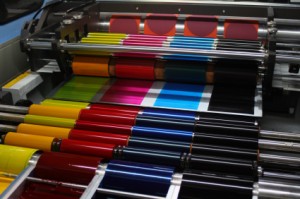It is very important to have labels on your CDs: This is not only so other people know which way up it is supposed to go into the machine, but also for a beautiful and professional-looking product. But the problem is, there are lots of different ways of disc printing so deciding which one is most suitable to your needs can be tricky! This article is aimed at helping you to figure out which one you want to use!
To start, there are four main techniques for printing CD labels: Lithographic, or offset, printing; thermal transfer printing; silkscreen printing; and inkjet printing. Each one has it own pros and cons.
Lithographic CD printing, or offset printing, involves putting your CD artwork onto a processing plate either through simply printing it from a computer or using photographic negatives and a chemical treatment. The plate is then ‘offset’, or imposed, onto a rubber blanket cylinder which applies it to the surface of the CD or DVD. This process looks incredibly good, and allows for high-quality photographic images and small text to be printed onto your CD. However disc printing in this way is only avaliable if you are replicating rather than duplicating discs as it is part of a whole manufacturing process. It can take up to ten days for the entire process to complete, thus is much less speedy than other printing methods. It is, however, a very good printing option if you need more than 1,000 discs to be made as large batches of discs are usually replicated anyway to save money. But, even taking this into account, Lithographic printing is not the cheapest option by any means.

When it comes to thermal transfer disc printing, each colour is placed separately onto a transfer ribbon which is then applied beneath a heated print-head. It seals the disc so that the label is waterproof and smudge free. Because the
images are taken directly from a computer, the process is very fast. It is cost-effective in small runs and also looks very good – the print quality is even better than with lithograph disc printing! (This is not to be confused with thermal printing which uses basically the same technique but can use only one colour and is slightly less precise in finish – though it is even faster and cheaper!) Both thermal and thermal transfer printing do not allow you to print right up to the edge of the disc and thermal transfer printing will quite often have to have a white base to print the other colours on top of.
Next, silkscreen printing, or simply ‘screen’ printing, allows disc printing by passing ink through a monofiliment screen. Each colour is put on separately, a different film acting as a stencil over the screen each time. This technique, while by far the cheapest for large runs of disc printing, can leave a grainy effect around colour gradients and text. Nevertheless it is perfectly acceptable for simple designs which use only a few colours. Be warned that the more colours you use with this technique, the less the quality of the image will be!
Lastly, using inkjet printing you can achieve a very high quality finish. This process involves simply printing straight onto a specially prepared disc, then covering it with a UV-resistant laquer so the image will not fade or get scratched. This is a very good method of printing, however it does tend to be pricier for large runs of disc printing, as the price is fixed and does not drop the larger the order becomes. In this way, it can be more economical to is silkscreen or lithographic printing methods.
I hope that this article has helped you make up your mind which printing method is right for your needs and good luck with your disc printing! Remember, if you can stretch the budget, it’s better to have a good-looking disc as it will attract more attention and consumers will like it better!
Tags: CD artwork, Disc design, Disc Manufacturing, Disc Printing, DVD Artwork, Printing Methods
